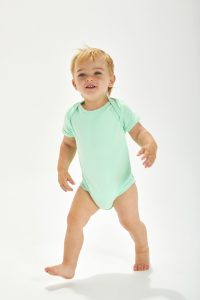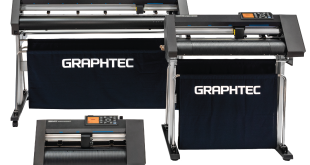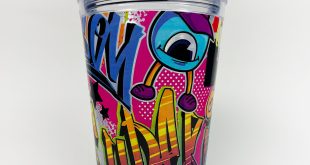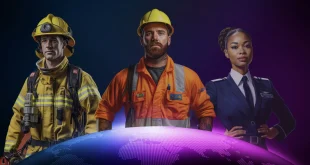
With a huge increase in demand for babywear, what are the trends and demands that have shaped the growing market? Erin Button, marketing executive at Mantis World, reports.
Trends usually pop up from every part of the world around us, but with babywear, there is a common sense of practicality entangled into their existence – after all, we care for our little ones and want them to be comfortable and easy to dress.
While you can now dress your baby in a mini leather jacket – a ridiculous concept in the centuries before us – the choice and variation of what the market now offers are growing rapidly, with not just a choice of design and material, but also the ethics surrounding the garment.
We first launched our Babybugz range back in 2005, and since doing so have seen an enormous boost in demand for environmentally friendly and easily personalised babywear. In recent years, babywear has transformed into different shapes and styles, with sustainability, quality and timeless design at the forefront of their decision-making for consumers. We have seen a rise of eco-conscious parents who only want the best for their children, without compromising on their values of protecting the planet.
The history
So where did it all begin? If we go as far back as the 18th century, baby clothes didn’t even include colour, let alone a funky slogan or a print. Traditionally, both baby boy and girl clothes were made white so they could be cleaned and bleached. In fact, gender was even more blurred through the notion that boys wore skirted garments until they were old enough to wear breeches. The practicality of the garment, plus the culture of reusing and handing down clothes to the younger generations was the norm of the time.
When the first washing machines finally came along in the mid-1900s, the floodgates were opened and different fabrics suddenly became available for babywear apparel. With new materials came new colours, and dissimilar to current belief, blue was designated for girls and pink for boys. But as time progressed, society shifted and the opposite became the norm. If you walked into a blue nursery now, you probably assume it’s a boy. If a newborn is wearing a pink hat, your first thought is most likely that it must be a girl. These days, thanks to prenatal testing, the merchandising market has become a goldmine. Whether it’s bodysuits, hats, nappies, car seats, pushchairs, blankets, teddies or anything else you can think of, merchandise has tended to be genderised by colour. The personalised baby market continues to repeat itself when the couple then expects their second child of the opposite gender and thus, buys all of the same exact products but now in the reverse colour.
Trends today
While colour does define gender subconsciously, we are developing as a modern society to live in more gender-fluid times. Reverting almost back to the centuries before us, neutral tones such as whites, greys and creams are becoming fashionable but also practical. We have seen an increase in demand for more unisex colours in recent years, including sage green and toffee. Our bestselling BZ10 Bodysuit and BZ02 Baby T have continued to show where colour trends are going in the babywear market.

One of the biggest impacts on modern babywear trends have been social media and fashion influencers. Celebrity yummy mummies have their youngsters dressed as miniature versions of themselves, with high-end brands replicating their designs from well-known adult wear collections. This then filters down into the ‘Instagram influencer’ culture, shaping public opinion and style. If you get to the bottom of the influencing food chain, the general public wants the quality and choice that those above the chain may have, but for a much more reasonable and affordable price. The babywear market of recent years has been sent into a flurry of consumer demand for more choices and variations of styles.
We now see collections that are marketed for the whole family, with styles for kids and adults to be purposefully co-ordinated. Seen frequently on popular social apps like Instagram and TikTok, it evokes a sense of family fun and togetherness. The #mommyandme hashtag has gained over 6.6 million posts on Instagram. These provide countless examples of not just how widespread over the globe the twinning trend is, but also the happiness and joy that comes with it – from both the adult and child. The Babybugz Essentials collection features a range of tees, hoods and sweats for babies that were developed alongside identical garments in Mantis Kids and Mantis for kids and adults. These trends can be as subtle or obvious as you feel comfortable with; T shirts might be somewhat more elusive, while tracksuits are more in your face. Adults with younger families may feel more inclined to make these purchases sooner than later before their little ones can rebel against the idea and dress themselves!
This follows hand in hand with the trend of personalisation in kidswear and babywear. With more advances in technology and how we can decorate a garment, printing businesses have allowed consumers and brands to totally innovate babywear. Many of these businesses saw a boom during the COVID-19 pandemic, and through lockdown, their online presence dominated the babywear market. Personalisation can make a product unique yet fashionable, providing an opportunity to embroider a name onto a blanket or create a unique design on a bodysuit. Personalised babywear makes a fantastic addition to a gift set, with brands putting together bodysuits, tees and accessories to create something really special. Giving birth is such a momentous and sentimental occasion, and when celebrating new life, a thoughtful gift can mean so much to new parents.

Environmentally focused
As parents become more eco-centric, the story and background behind a child’s garment become more and more important. We always want the best for our children, and consumers are increasingly searching for transparency regarding where their products come from and how they were made. Modern customer trends and opinions have shown an increase in responsibility when buying clothes with major concerns for including the standards of how the material is sourced, as well as the conditions and treatment of those in the supply chain.
In 2020, we started putting QR codes into our care labels, allowing customers to see the full supply chain by simply scanning with their phone. They also give a full run-down of the environmental impact of the garment. Organic cotton is grown naturally without genetically modified seeds, artificial fertilisers or chemical pesticides. This makes it friendlier to sensitive skin. Babywear made from 100% organic cotton boasts a high quality and soft feel which appeals to the new generation of parents who soon enough, will make up the majority of consumers. Babybugz has been using organic cotton since 2005, and we have long known it’s the go-to for babywear.
What we pride ourselves on is our dedication to an ethical supply chain while consistently manufacturing high-quality and long-lasting garments. We have been doing so for over two decades and believe that our Babybugz range is the perfect choice for babywear, offering consumers choice and quality without compromising on values.
 Printwear & Promotion The Total Promotional Package
Printwear & Promotion The Total Promotional Package




